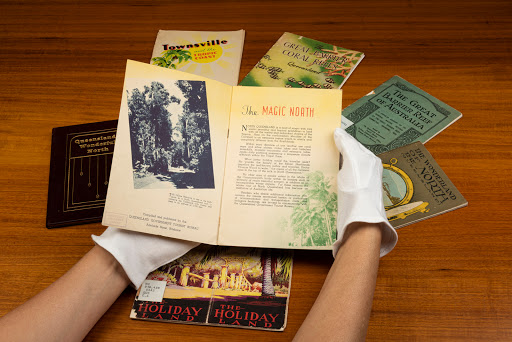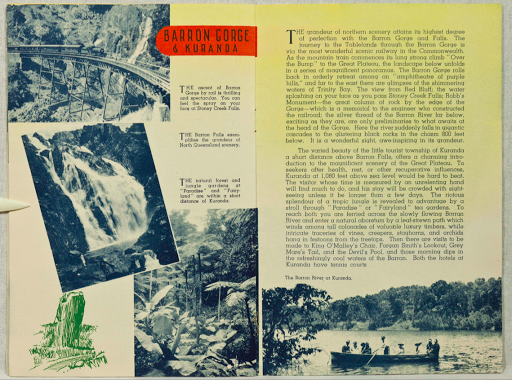Our forty-third treasure, from the North Queensland Collection, is a selection of Queensland Government Tourism Publications (1900 - 1950).
Trisha Fielding discusses this treasure.
The Queensland Government Intelligence and Tourist Bureau was established in 1907. Its main activities included serving as a booking agency and producing films and brochures to promote tourism in Queensland. It heavily utilised Queensland’s mild climate and stunning scenery in its promotions.
One of the Bureau’s earliest promotional booklets – Within the Barrier: Tourists’ Guide to the North Queensland Coast – was written by Edmund James Banfield. First published by Messrs T. Willmett & Co. of Townsville in 1907, it preceded the publication in 1908 of his popular book Confessions of a Beachcomber – about his life on Dunk Island. Sometime after its formation in April 1907, the Bureau published a print run of 5,000 copies of Within the Barrier for distribution in Australia and in London.
A retired journalist, who had been a sub-editor of the Townsville Daily Bulletin in its early years, Banfield proved an excellent mouthpiece for the Bureau. His books about his idyllic life on Dunk Island mirrored the government’s rhetoric, which focused on the state’s naturally beautiful attractions, and the mild climate. In My Tropic Isle (1911) Banfield wrote of Dunk:
‘Such is this delicious Isle – this unkempt, unrestrained garden where the centuries gaze upon perpetual summer. Small it is, and of varied charms – set in the fountain of time-defying youth. Abundantly sprinkled with tepid rains, vivified by the glorious sun, its verdure tolerates no trace of age.’
Other early publications from the Bureau included Queensland the Winter Paradise of Australasia; North Queensland: the Holiday Land and The Wonderland of the North: Scenic Beauties of North Queensland. All were filled with verbose descriptions of popular Queensland destinations, along with a wealth of supporting photographs (though many were grainy, low quality black and white pictures that did not reproduce particularly well).
In 1929, responsibility for the Bureau was transferred to the Railway Department. By this time, the railway had reached Cairns, which meant that the Great Barrier Reef could legitimately be promoted as a holiday destination accessible by rail. In the early 1930s, the word Intelligence was dropped from the Bureau’s name and it became the more simplified - Queensland Government Tourist Bureau.
The Great Barrier Coral Reefs, published around 1939, was a much slicker publication than many of the Bureau’s earlier booklets. It traded unashamedly on romantic notions of the reef and its islands. Written largely to promote the Capricorn region, it included stylised maps of islands in the Whitsunday and Cumberland groups that mimicked treasure maps – suggesting that a ‘world of fantasy’ awaited the reef tourist. ‘Is there any fairer garden on land than the coral gardens beneath these translucent waves?’ it asked.
Over the course of 2020, JCU Library's Special Collections will be unveiling 50 Treasures from the collections to celebrate 50 years of James Cook University.
Author Biography
Trisha Fielding is an historian and writer whose published works include the books Neither Mischievous nor Meddlesome: the remarkable lives of North Queensland’s independent midwives 1890-1940, Queen City of the North: a history of Townsville, and the history blogs North Queensland History and Women of the North. She holds a Master of History degree from the University of New England and a Bachelor of Arts with Distinction from the University of Southern Queensland. Trisha also works part time in JCU Library’s Special Collections.
Trisha Fielding discusses this treasure.
The Queensland Government Intelligence and Tourist Bureau was established in 1907. Its main activities included serving as a booking agency and producing films and brochures to promote tourism in Queensland. It heavily utilised Queensland’s mild climate and stunning scenery in its promotions.
 |
| A selection of Queensland Government tourism publications, North Queensland Collection, JCU Library Special Collections. Photo: ©Michael Marzik |
 |
| Edmund Banfield with wife Bertha, on Dunk Island. Photo: NQ Photographic Collection, JCU Library Special Collections, Helen Dyer Album, NQID 2765 |
‘Such is this delicious Isle – this unkempt, unrestrained garden where the centuries gaze upon perpetual summer. Small it is, and of varied charms – set in the fountain of time-defying youth. Abundantly sprinkled with tepid rains, vivified by the glorious sun, its verdure tolerates no trace of age.’
 |
| Pages from Cairns and Hinterland, Queensland Government Tourist Bureau |
Other early publications from the Bureau included Queensland the Winter Paradise of Australasia; North Queensland: the Holiday Land and The Wonderland of the North: Scenic Beauties of North Queensland. All were filled with verbose descriptions of popular Queensland destinations, along with a wealth of supporting photographs (though many were grainy, low quality black and white pictures that did not reproduce particularly well).
In 1929, responsibility for the Bureau was transferred to the Railway Department. By this time, the railway had reached Cairns, which meant that the Great Barrier Reef could legitimately be promoted as a holiday destination accessible by rail. In the early 1930s, the word Intelligence was dropped from the Bureau’s name and it became the more simplified - Queensland Government Tourist Bureau.
 |
| Stylised map of the Whitsunday Islands, featured in The Great Barrier Coral Reefs, Queensland, Australia, Queensland Government Tourist Bureau |
The Great Barrier Coral Reefs, published around 1939, was a much slicker publication than many of the Bureau’s earlier booklets. It traded unashamedly on romantic notions of the reef and its islands. Written largely to promote the Capricorn region, it included stylised maps of islands in the Whitsunday and Cumberland groups that mimicked treasure maps – suggesting that a ‘world of fantasy’ awaited the reef tourist. ‘Is there any fairer garden on land than the coral gardens beneath these translucent waves?’ it asked.
Over the course of 2020, JCU Library's Special Collections will be unveiling 50 Treasures from the collections to celebrate 50 years of James Cook University.
Author Biography
Trisha Fielding is an historian and writer whose published works include the books Neither Mischievous nor Meddlesome: the remarkable lives of North Queensland’s independent midwives 1890-1940, Queen City of the North: a history of Townsville, and the history blogs North Queensland History and Women of the North. She holds a Master of History degree from the University of New England and a Bachelor of Arts with Distinction from the University of Southern Queensland. Trisha also works part time in JCU Library’s Special Collections.
Comments